Second Day, June 7, 2002, Volunteer Trail Crew
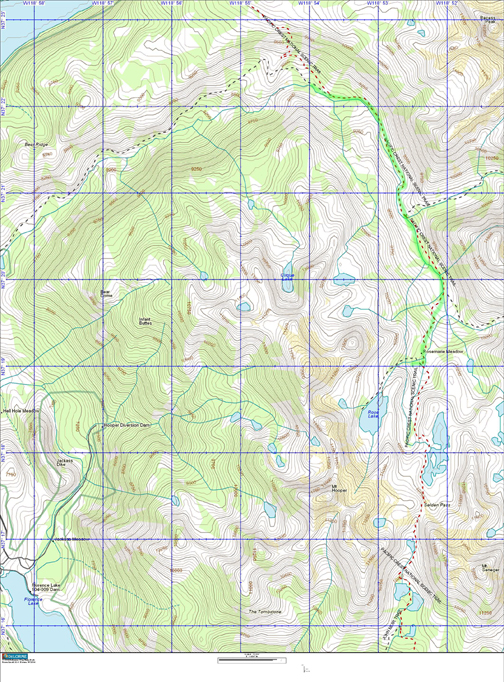 Map of the second day's hiking. From "Boulder Camp" to Rosemarie Meadow.
Map of the second day's hiking. From "Boulder Camp" to Rosemarie Meadow.
(day2_small.jpg)
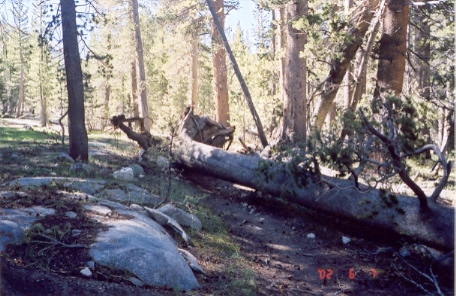 Second day, largest tree of the trip.
Second day, largest tree of the trip.
(10_75.jpg, photograph by Eric)
After breaking camp and leaving a large tree near camp for the North Crew
to work on, we continued on. About a mile or so out of camp we made a new
water bar on the trail where there was a small creek running down the
middle of the trail. We then got to a down tree that fell in the middle
of a meadow and crossed the trail. This was one of the two places where
we had any type of argument between the crew members and it revolved
around Steve thinking that it would be a poor idea if I cut my leg wide
open by sawing in a very unsafe manner and I thinking that, since I
hadn't actually cut my leg yet that there wasn't anything to worry about.
(Maybe I should look at that scar on my knee that I put there in the
1950's with a crosscut saw!) After all we had "doc" with us.
Shortly after the meadow, the trail we were on (Forest Service trail
28E01) meets up with the Pacific Crest National Scenic Trail and ends.
(This is normally called either the Pacific Crest Trail or PCT.) At this
point the North Crew turned left and proceeded on north to Lake Thomas A.
Edison (Edison Lake) while we kept on straight ahead. We were now on the
PCT.
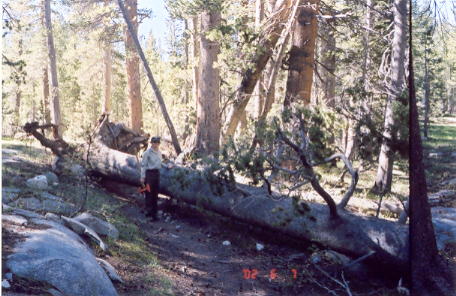 Dolly and the largest tree.
Dolly and the largest tree.
(11_75.jpg, photograph by Eric)
I asked Dolly to stand in front of this tree to give some idea of its
size. Note that it is gracefully lying almost full length down the trail.
It took some thinking to ensure that when we cut the tree, that we could
then easily roll the pieces out of the way. Look carefully at Dolly's axe
and you will note that it is still in its sheath. This is a safety item
and it is always in its sheath unless it is in actual use.
A nice feature of this tree is its large and healthy set of roots that we
got to remove. When the roots came out of the ground they left a large
hole that we also got to fill in. The various thick rootlets had to be
cut off before we could start to cut the tree into smaller pieces for
removal from the trail.
This was an unusual tree for another reason. It was not an old dead one
that had finally fallen down. When it fell down it was still a living,
viable tree. This means that it was full of important tree things like
pitch and sap.
- Pitch, being quite sticky, has to be constantly removed from our saw
as it causes binding. This is what we used the diesel fuel for. Some say
that we should use citrus based pitch removers, but none of us trusted
them compared to good old diesel fuel. Although we didn't have any
problems with bears, I worry that they might like the smell of a citrus
based pitch cleaner, while they do not appear to like diesel fuel.
- Then there is the sap to work with. Normally the trees that fall
down have been dead for some time and are reasonably dry. However here
the tree was "fresh" and with its sap the wood was two to four times as
heavy as wood from an old dry dead tree.
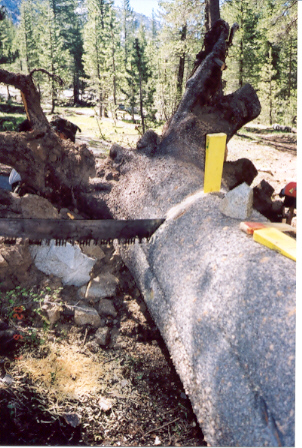 Wedging and sawing the largest tree. Note the large/long saw chips on the ground and coming out of the cut.
Wedging and sawing the largest tree. Note the large/long saw chips on the ground and coming out of the cut.
(12_75.jpg, photograph by Eric)
Here we are about a quarter of the way through our first cut on the tree.
Note in the background that major parts of the roots have been removed.
Some of them are the size of some of the trees that we were cutting on
the trail earlier on!
On top of the tree we have a wedge that is there to prevent the tree
binding the saw as we cut further through the tree. One problem with
using wedges is that we cannot pound them in too far as they then hit the
saw! The only type of wedges that we use are these plastic "felling"
wedges. The difference between these felling wedges and the common
"splitting" wedges is that these are quite narrow. Being made out plastic
they do not weigh as much a wrought iron splitting wedges and they do not
damage the "stone" sledges that we use. (If we were using a chain saw,
which we are not allowed in the primitive areas that we work in, and the
saw's chain hits the wedge, the chain won't be damaged.)
Also visible is the rock that we were using as a sledge hammer.
Note that the bark has been removed from around where the saw is cutting.
This was done to help keep the saw as sharp as possible. Some types of
bark cause saws to become dull very quickly and so it is always removed.
A crosscut saw cuts by using its "cutting teeth" to score, and cut, both
sides of the cut. Then the "raker teeth" scrape the wood out from the
middle of the cut. The result of this is that when the saw is sharp and
the tree is fresh (not from an old dried out tree), we get nice long
"chips" coming out of the cut. As is shown here, the long chips are about
two to three inches long!
About two-man crosscut saws
For those of you that are interested in some more information about
two-man crosscut saws, I have extracted some information from the Forest
Service's "The Crosscut Saw Manual". (I found it using Google and a
search field of "crosscut saw manual", the double quotes are needed.)
On this hike our primary saw was a "perforated lace tooth" "felling type"
that was quite sharp. (A felling saw is thinner and more flexible than a
bucking type saw.)
There is always a sheath on crosscut saws when they are
not in use. (I have never seen anything else than an old piece of fire
hose used as a sheath.) Old fire hose has several advantages over
anything else:
- Low cost. Available for FREE from most firemen when it is clear that
it will only be used to protect crosscut saws.
- It is lined with rubber which is "kind" to the sharpened teeth and
protects people working/transporting the saw.
- It is flexible. Some use plywood boxes for their saws. This is OK
when the saw is being transported by vehicle, or is being sent out for
sharpening. (Always try to have a professional like Dolly sharpen your
saw.)
- Is light weight. The old canvas/rubber construction of fire hoses
weights less than leather or plywood solutions.
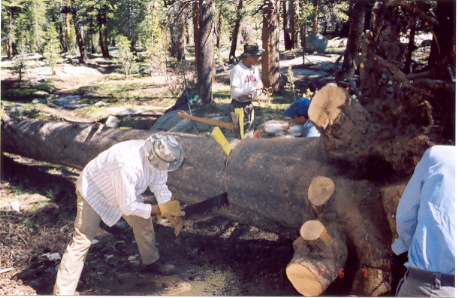 Ron and Ray cutting the largest tree, with Ed in the background.
Ron and Ray cutting the largest tree, with Ed in the background.
(13_75.jpg, photograph by Eric)
To remove this tree, we needed two cuts. This is the first of the cuts
being made. Note the ax placed into the cut. This is to reduce the chance
that the tree will "roll" unexpectedly. It is in about an inch or so. As
we are now further though the tree, we now have three of our four wedges
in use and they are pounded in as far as we can get them.
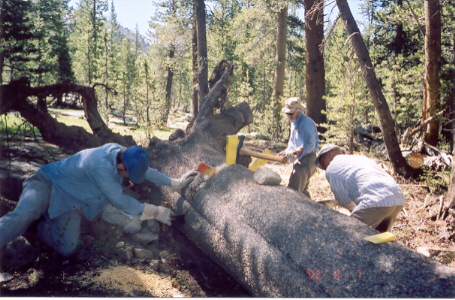 Ray and Ron with the largest tree, Steve in the background.
Ray and Ron with the largest tree, Steve in the background.
(14_75.jpg, photograph by Eric)
While we were here, we had a "through hiker" come along. He was solo
hiking the Pacific Crest Trail and had gotten here from the southern end.
We talked a bit and asked him about the trail ahead of us. He had just
come over Seldon Pass and had forded Bear Creek. He said that the ford
was "about crotch high". This was bad news for us as we estimated that he
had probably forded the creek about one to two hours before and we knew
that we had at least an hour more of work to do here. As the sun melts
snow and the melted snow makes runoff which ends up in Bear Creek. We
knew that crossing Bear Creek would be a problem later on.
Additional talking with the hiker indicated that there would not be too
much of a problem with the rest of the trail. He said that there was
"some snow and ice ahead" but that it shouldn't cause any real problems
for us. HA! Maybe we should have noticed that he had an
ice ax on his pack and given the subject some additional thought.
Next time we do this we should stop by at the Vermilion Store and talk
with any through hikers about trail conditions that we might encounter.
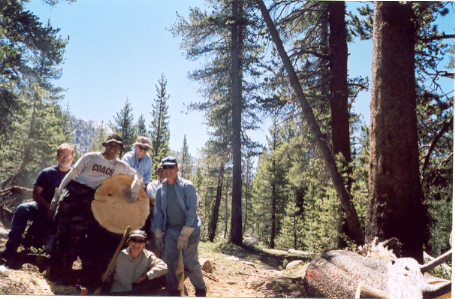 Eric, Ed, Steve, Dolly, Ron and Ray with our 210+ year old tree after it was off the trail.
Eric, Ed, Steve, Dolly, Ron and Ray with our 210+ year old tree after it was off the trail.
(15_75.jpg, photograph by Eric' camera)
While the others were busy cutting the tree into pieces. I counted the
rings to determine how old it was. I got up to at least 210 rings, but
some of them were quite close together and I probably under counted.
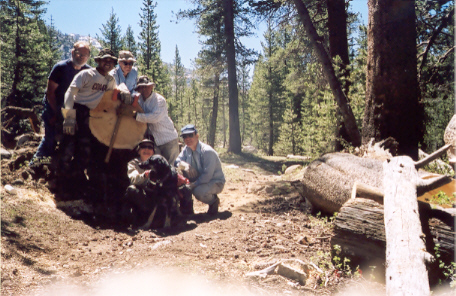 Better version of picture 15.
Better version of picture 15.
(16_75.jpg, photograph by Eric's camera)
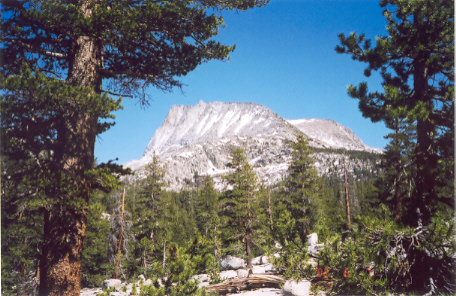 Seven gables.
Seven gables.
(17_75.jpg, photograph by Eric)
Dolly climbed these once and reports that the climb is "easy". From what
I have seen of her hiking, anything that is easy for her is going to be
difficult for an average person.
Eventually we finished with the 210+ year old tree and continued on up
the trail. We walked through a long distance of wet trail with many small
streamlets crossing it. All of these were easily crossed by "boulder
hopping" and careful foot placement. We then got to the Hilgard Branch of
Bear Creek coming out of Lake Italy which most of us forded. (Ray up the
creek and found a downed tree that he used to cross over on.)
I didn't have anything other than my boots to wear in crossing the creek
and I had to wear them as the creek bed was filled with rocks. I had been
in this area in August 1999 and knew that the creek would be here, but
back then it was easy to jump over, so all I did was plan to change my
socks into something dry after crossing it. At least Steve and Ron had
planned far enough to carry "Teva" sandals with them. They both stopped
and put them on and crossed over then put their dry boots/socks back on.
(I have since bought Tevas for myself.)
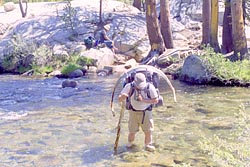 "Normal" crossing of Bear Creek on a different trip
"Normal" crossing of Bear Creek on a different trip
(113_13.jpg, photographer unknown)
Crossing Bear Creek is normally done at the ford. This is picture that
was taken last year, during late Summer, of Scott (who was not with us on
this trip) crossing. Note that the water just bearly gets up to his
knees. Note the way that crosscut saws are carried. There are two
problems with carrying a crosscut saw: the first one is that it tends to
"snag" on the bushes that line the trail and the other is that if the saw
is bent, in too tight a curve, it will break! (Some saw skills are hard
to learn! At least one saw has been broken by trail crew volunteers, but
not on this trip nor during this year.) Even with these problems, this is
the best/safest way to carry a full size crosscut saw.
The teeth are always pointing "backwards", i.e. away from the head or any
thing else which might get damaged. It is not very obvious in this small
picture, but Scott has undone the waist and sternum belts on his
backpack. This is so that if he falls, he can quickly get out of the
backpack.
A mile or two later on we got to the ford on Bear Creek and decided that
the level was too high and the water was rushing by too quickly for a
safe fording. We had lunch and went down creek several hundred yards to
find a usable fording place. (Any time that rushing water is knee high,
or more, it is unsafe to cross.) Ron finally found a place that looked
OK. He took off his pants and put on his Tevas and crossed over. (By
taking off his pants, Ron not only kept them dry but reduced the effect
of the rapidly moving water on his legs.) When he stepped off the bank at
the edge of the creek he got up to about mid-thigh, but as the water
wasn't flowing very fast at the edge it was OK. As he got to the middle
of the creek, the water was somewhat shallower and faster. Here he used
his shovel for support and continued on. When Ron got to what we thought
was the other side, he left his pack there and came back to stand in the
freezing water and help the rest of us across.
I was next and I walked into the water and tried to use my shovel for
support. Using the shovel for support was not too successful. I finally
listened to Ron and turned it around so that the wooden part was down and
I was holding on to the metal end. Until I did this the metal "shovel"
end was constantly being knocked aside and I could not get it all the way
down to the creek bed.
After I passed Ron, I went on a bit and found that what we had thought
was the other bank, was just an island in the middle of the creek.
Fortunately, there was a relatively shallow ford from the island to the
real bank. This was the area, where one of us had an accident and fell
into the water. Glad it was here as earlier on we would have had to chase
down the creek to do a rescue! By this time Ron was complaining about his
legs getting cold and numb. When we got across the creek we took a short
break in the sun to dry out and warm up.
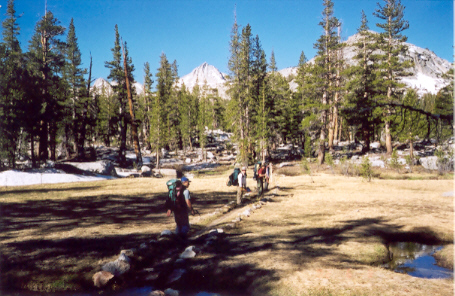 Ray, Ron, Ed and Steve on way to Rosemarie meadow.
Ray, Ron, Ed and Steve on way to Rosemarie meadow.
(18_75.jpg, photograph by Eric)
The rest of the day consisted of hiking up to Rosemarie Meadow. On the
way Ray, Ed and Steve cleaned out several water bars. I got to the top of
the hill and Dolly had Shackelton tried to find me. (Shackelton is in the
process of being trained to be a search dog and practice is always
helpful. It was easy on me as I just sat by the side of the trail and
waited to be found! Shackelton did find me.) On the entire hike, I never
heard Shackelton bark once. A very nice and well behaved dog!
Dolly had camped in Rosemarie Meadow the preceding year with a group
from the Sierra Club and had lost Shackelton's leash here. She went back
to the same place that she had camped in last year and was able to
retrieve the leash in good condition. Dolly never camped "near" the rest
of the team, she was probably always one to two hundred yards away from
us.
At Rosemarie Meadow, Steve went up to Rose Lake. He reported on the way
back that there was "a lot of snow up there". As we had snow in several
large patches around where we were, I didn't think too much about it.
After Steve got back we all took a short walk to see the old Forest Snow
Survey cabin. It was locked and we couldn't get in. Dolly had been in it
once before and reported that all it had inside was many rat droppings.
That night it got kinda cold and when I got up in the morning my boots
were frozen. They were not totally hard, but they were sure
uncomfortable! After walking around in them for an hour or so, I could at
least do up the laces.
End of the second day











